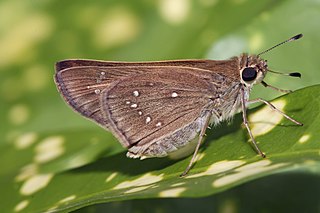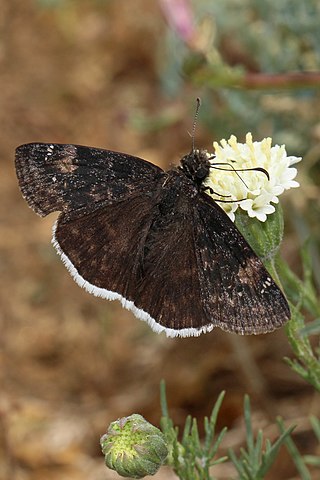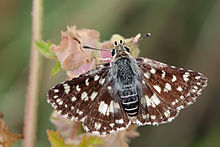
The Neotropical realm is one of the eight biogeographic realms constituting Earth's land surface. Physically, it includes the tropical terrestrial ecoregions of the Americas and the entire South American temperate zone.

The Nymphalidae are the largest family of butterflies, with more than 6,000 species distributed throughout most of the world. Belonging to the superfamily Papilionoidea, they are usually medium-sized to large butterflies. Most species have a reduced pair of forelegs and many hold their colourful wings flat when resting. They are also called brush-footed butterflies or four-footed butterflies, because they are known to stand on only four legs while the other two are curled up; in some species, these forelegs have a brush-like set of hairs, which gives this family its other common name. Many species are brightly coloured and include popular species such as the emperors, monarch butterfly, admirals, tortoiseshells, and fritillaries. However, the under wings are, in contrast, often dull and in some species look remarkably like dead leaves, or are much paler, producing a cryptic effect that helps the butterflies blend into their surroundings.

Skippers are a family of the Lepidoptera named the Hesperiidae. Being diurnal, they are generally called butterflies. They were previously placed in a separate superfamily, Hesperioidea; however, the most recent taxonomy places the family in the superfamily Papilionoidea, the butterflies. They are named for their quick, darting flight habits. Most have their antenna tips modified into narrow, hook-like projections. Moreover, skippers mostly have an absence of wing-coupling structure available in most moths. More than 3500 species of skippers are recognized, and they occur worldwide, but with the greatest diversity in the Neotropical regions of Central and South America.

Swallowtail butterflies are large, colorful butterflies in the family Papilionidae, and include over 550 species. Though the majority are tropical, members of the family inhabit every continent except Antarctica. The family includes the largest butterflies in the world, the birdwing butterflies of the genus Ornithoptera.

The superfamily Papilionoidea contains all the butterflies except for the moth-like Hedyloidea.

Lycaenidae is the second-largest family of butterflies, with over 6,000 species worldwide, whose members are also called gossamer-winged butterflies. They constitute about 30% of the known butterfly species.

Riodinidae is the family of metalmark butterflies. The common name "metalmarks" refers to the small, metallic-looking spots commonly found on their wings. The 1532 species are placed in 146 genera. Although mostly Neotropical in distribution, the family is also represented both in the Nearctic, Palearctic, Australasian (Dicallaneura), Afrotropic, and Indomalayan realms.

Grass skippers or banded skippers are butterflies of the subfamily Hesperiinae, part of the skipper family, Hesperiidae. The subfamily was established by Pierre André Latreille in 1809.

Lycaeninae, the coppers, are a subfamily of the gossamer-winged butterflies (Lycaenidae).

The subfamily Theclinae is a group of butterflies, often referred to as hairstreaks, with some species instead known as elfins or by other names. The group is part of the family Lycaenidae, the "gossamer-winged butterflies". There are many tropical species as well as a number found in the Americas. Tropical hairstreaks often have iridescent blue coloration above, caused by reflected light from the structure of the wing scales rather than by pigment. Hairstreaks from North America are commonly brown above. Few Theclinae are migratory. Members of this group are described as 'thecline'.

The Eudaminae are a subfamily of skipper butterflies. Their original type genus Eudamus is today a junior synonym of Urbanus. They are largely found in the Neotropics, with some extending into temperate North America, and one genus, Lobocla, endemic to East Asia.

The Pyrgini are a tribe in the skipper butterfly subfamily Pyrginae. Formerly, when only four tribes of Pyrginae were recognized, the Pyrgini contained the largest number of genera among these. But this overly wide delimitation has since turned out to be paraphyletic.

The Celaenorrhinini are a tribe of spread-winged skippers in the skipper butterfly subfamily Tagiadinae.

Euschemon is a genus of skipper butterflies in the family Hesperiidae. It is monotypic, being represented by the single species Euschemon rafflesia, commonly known as the regent skipper and is found in Australia.

Autochton is a genus of skipper butterflies. They belong to the subfamily Eudaminae, which was long included with the spread-winged skippers (Pyrginae) as a tribe. They are found from Mexico to South America.

Dyscophellus is a genus of largely Neotropical butterflies in the family Hesperiidae. The genus has been the subject of recent revisions based on genome analysis. It is currently placed in tribe Phocidini within the subfamily Eudaminae.

The Achlyodidini are a tribe in the skipper butterfly subfamily Pyrginae. Many species of them are notable for their gaudy colors and the unusually-shaped wings, which look as if the forewing tips have been squarely cut off. They are only found in the Americas, with few occurring out of tropical areas.

The Carcharodini are a tribe in the skipper butterfly subfamily Pyrginae. They are a very diverse but quite plesiomorphic and inconspicuous group distributed throughout the tropics.

The Erynnini are a tribe in the skipper butterfly subfamily Pyrginae. They are a moderately diverse but quite plesiomorphic and inconspicuous group, and except for the Holarctic species of the type genus Erynnis occur only in the Neotropics.





















